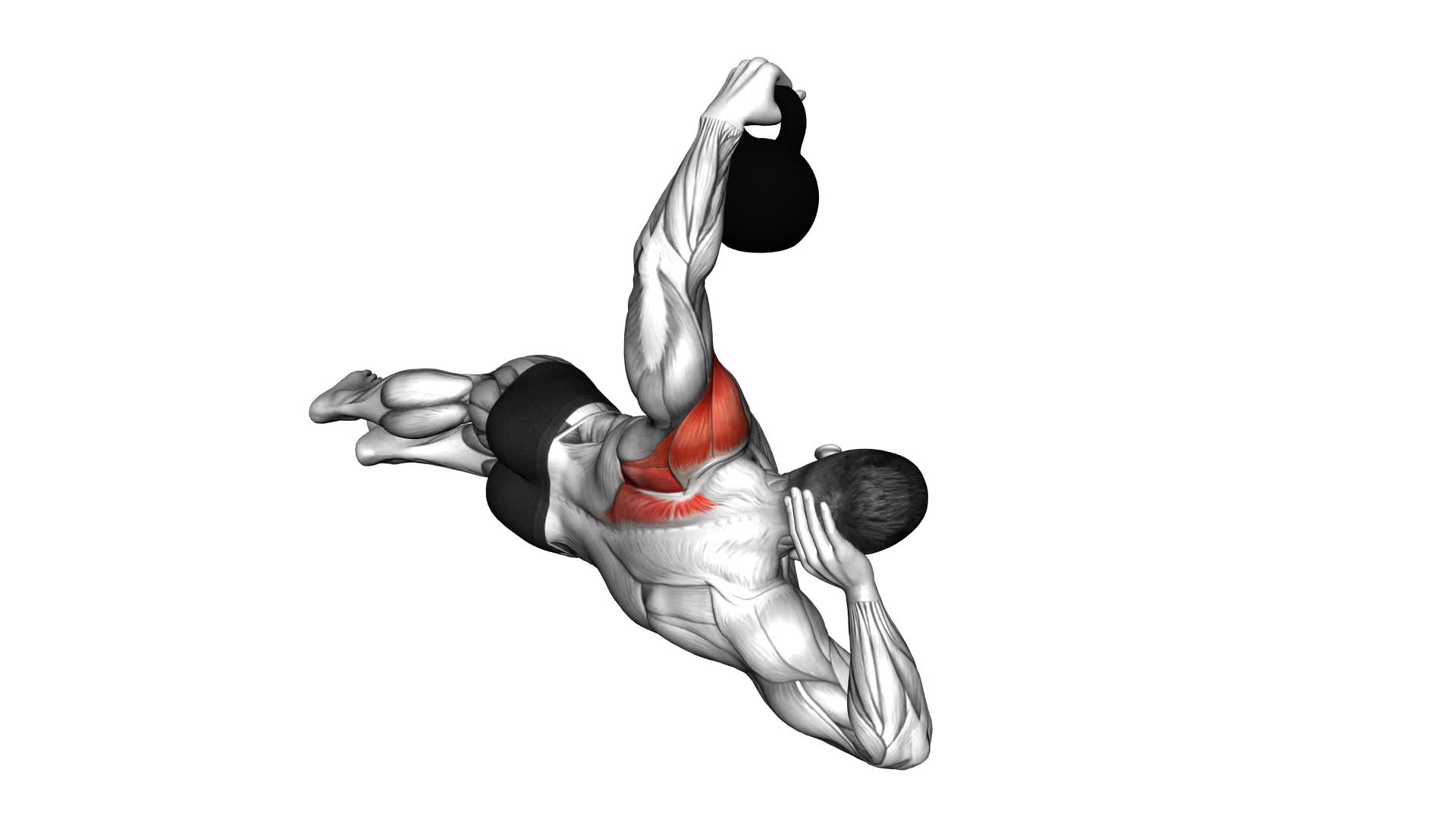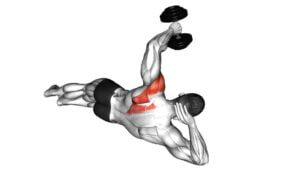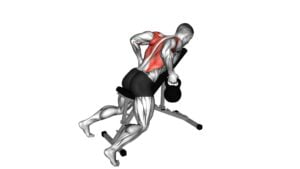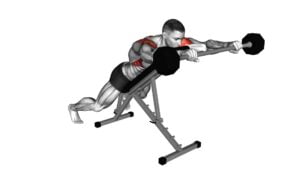Kettlebell Lying on Floor Rear Delt Raise – Video Exercise Guide & Tips

Are you looking for an effective exercise to target your rear delts? Look no further than the kettlebell lying on floor rear delt raise.
Watch This Exercise Video
This exercise is great for building strength and definition in your shoulder muscles.
In this video exercise guide, you'll learn the proper form and technique, common mistakes to avoid, and tips to maximize your results.
So grab a kettlebell and get ready to sculpt those rear delts!
Key Takeaways
- Targets the rear deltoid muscles
- Engages rear deltoids in a compound movement
- Builds strength and definition in shoulder muscles
- Stabilizes and strengthens the shoulder joint
Benefits of Kettlebell Lying on Floor Rear Delt Raise
One benefit of performing the Kettlebell Lying on Floor Rear Delt Raise is that it targets the rear deltoid muscles by engaging them in a compound movement. The rear deltoids are the muscles located at the back of your shoulders, and they play a crucial role in stabilizing and strengthening the shoulder joint. By engaging these muscles in the Kettlebell Lying on Floor Rear Delt Raise exercise, you can effectively work on developing and toning them.
This exercise is specifically designed to isolate and strengthen the rear deltoids, making it an excellent choice for those looking to focus on this particular muscle group. The compound movement involved in this exercise allows for greater muscle activation and engagement, leading to more effective muscle development.
In addition to targeting the rear deltoids, the Kettlebell Lying on Floor Rear Delt Raise also engages other muscles in the shoulders and upper back, further enhancing shoulder strength and stability. By incorporating this exercise into your shoulder strengthening routine, you can improve your overall shoulder function and reduce the risk of injury.
Proper Form and Technique for Kettlebell Lying on Floor Rear Delt Raise
To perform the Kettlebell Lying on Floor Rear Delt Raise with proper form and technique, follow these steps:
- Lie flat on your back.
- Engage your rear deltoid muscles by lifting the kettlebell off the floor.
- Focus on squeezing your shoulder blades together and keeping your arms straight.
- Exhale as you lift the kettlebell off the floor to engage your core muscles and stabilize your body.
- Inhale as you lower the kettlebell back down to relax and prepare for the next repetition.
- Maintain a controlled movement throughout the exercise, avoiding jerking or swinging motions.
- Keep your core engaged and your back flat on the floor to prevent strain or injury.
- Consistency and proper form are key to maximizing your rear deltoid muscle activation.
Remember to breathe properly, maintain control, and focus on engaging your rear deltoids throughout the exercise.
Common Mistakes to Avoid During Kettlebell Lying on Floor Rear Delt Raise
When performing the Kettlebell Lying on Floor Rear Delt Raise, be mindful of common mistakes to avoid in order to maximize the effectiveness of the exercise. Here are some tips for improvement:
- Using too heavy of a weight: One common mistake is using a kettlebell that's too heavy for your strength level. This can compromise your form and lead to injury. Start with a lighter weight and gradually increase as you become more comfortable and confident.
- Lifting the hips off the floor: To properly engage your rear deltoids, it's important to keep your hips firmly on the floor throughout the exercise. Lifting your hips can shift the focus away from the targeted muscles and reduce the effectiveness of the movement.
- Rounding the shoulders: Another mistake to avoid is allowing your shoulders to round forward during the exercise. This not only reduces the activation of the rear deltoids, but also puts unnecessary strain on the neck and upper back. Keep your shoulders pulled back and down throughout the movement.
- Neglecting full range of motion: Make sure to fully extend your arms and squeeze your shoulder blades together at the top of the movement. Neglecting the full range of motion can limit the engagement of the rear deltoids and limit the results you can achieve.
Tips to Maximize Results of Kettlebell Lying on Floor Rear Delt Raise
To maximize your results with the Kettlebell Lying on Floor Rear Delt Raise, it's important to incorporate these tips into your routine. By following these tips, you can ensure that you're performing the exercise correctly and reaping the full benefits.
One common mistake to avoid is using too heavy of a kettlebell. While you may feel tempted to grab the heaviest weight available, using a weight that's too heavy can lead to improper form and potential injury. Start with a lighter kettlebell and gradually increase the weight as you become more comfortable with the exercise.
Another mistake to avoid is rushing through the exercise. It's important to perform each repetition with control and focus. Take your time and focus on engaging your rear deltoids throughout the movement. This will help to maximize the effectiveness of the exercise and prevent any unnecessary strain on other muscles.
Lastly, remember to breathe properly during the exercise. Many people tend to hold their breath or forget to breathe while performing strength exercises. Breathing helps to oxygenate your muscles, allowing them to work more efficiently. Inhale as you lower the kettlebell, and exhale as you raise it.
Variations and Progressions for Kettlebell Lying on Floor Rear Delt Raise
To vary and progress the Kettlebell Lying on Floor Rear Delt Raise exercise, you can incorporate different equipment or increase the challenge level. Here are some variations and progressions you can try:
- Resistance Bands: Attach resistance bands to the kettlebell handles and anchor them to a sturdy object. This will add extra resistance and make the exercise more challenging.
- Dumbbells: Instead of using a kettlebell, you can use dumbbells to perform the exercise. This will change the grip and muscle activation, providing a different stimulus to your rear delts.
- Single-Arm Variation: Perform the exercise with one arm at a time. This will increase the demand on your stability muscles and allow for better isolation of each side.
- Swiss Ball: Place a Swiss ball between your back and the floor. This will create an unstable surface, forcing your core muscles to work harder to maintain balance and stability.
Frequently Asked Questions
How Many Sets and Repetitions Should I Do for the Kettlebell Lying on Floor Rear Delt Raise?
To determine the number of sets and repetitions for the kettlebell lying on floor rear delt raise, it's important to consider your fitness goals and current fitness level. A good starting point is 3-4 sets of 8-12 repetitions. However, you can adjust the sets and reps based on your needs.
If you don't have a kettlebell, you can use alternatives like dumbbells or resistance bands. Remember to listen to your body and gradually increase the intensity as you progress.
Can I Use Dumbbells Instead of Kettlebells for This Exercise?
Yes, you can use dumbbells instead of kettlebells for this exercise.
While kettlebells offer unique benefits such as increased grip strength and stability, dumbbells can still effectively target your rear delts.
Make sure to choose an appropriate weight and maintain proper form throughout the exercise.
Remember to squeeze your shoulder blades together and engage your rear deltoids for maximum results.
Is It Necessary to Warm up Before Performing the Kettlebell Lying on Floor Rear Delt Raise?
Before performing the kettlebell lying on floor rear delt raise, it's highly recommended to warm up. Warming up increases blood flow to your muscles, making them more flexible and less prone to injury.
It also prepares your body for the upcoming exercise, allowing you to perform with proper form and technique. So, take a few minutes to warm up and reap the benefits of a safe and effective workout.
Can I Incorporate This Exercise Into a Full-Body Workout Routine?
Yes, you can definitely incorporate the kettlebell lying on floor rear delt raise into your full-body workout routine.
This exercise is a great way to target your rear deltoids and improve shoulder strength and stability.
Incorporating kettlebell exercises like this one into your routine can provide a variety of benefits, such as increased muscle activation, improved coordination, and enhanced overall body strength.
Are There Any Modifications for Individuals With Shoulder or Back Injuries?
If you have shoulder or back injuries, there are modifications you can make to the Kettlebell Lying on Floor Rear Delt Raise exercise. It's important to prioritize your safety and avoid exacerbating any existing injuries.
You can try using lighter weights or even bodyweight exercises that target the same muscles without putting too much strain on your shoulders or back.
Remember to consult with a healthcare professional or a certified trainer for personalized modifications that suit your specific condition.
Conclusion
In conclusion, the kettlebell lying on floor rear delt raise is a highly effective exercise for targeting the rear deltoid muscles. By maintaining proper form and avoiding common mistakes, you can maximize the benefits of this exercise.
Additionally, incorporating variations and progressions can help you continue challenging your muscles and achieving optimal results. Remember to always prioritize safety and consult with a fitness professional if needed.

Author
Years ago, the spark of my life’s passion ignited in my mind the moment I stepped into the local gym for the first time. The inaugural bead of perspiration, the initial endeavor, the very first surge of endorphins, and a sense of pride that washed over me post-workout marked the beginning of my deep-seated interest in strength sports, fitness, and sports nutrition. This very curiosity blossomed rapidly into a profound fascination, propelling me to earn a Master’s degree in Physical Education from the Academy of Physical Education in Krakow, followed by a Sports Manager diploma from the Jagiellonian University. My journey of growth led me to gain more specialized qualifications, such as being a certified personal trainer with a focus on sports dietetics, a lifeguard, and an instructor for wellness and corrective gymnastics. Theoretical knowledge paired seamlessly with practical experience, reinforcing my belief that the transformation of individuals under my guidance was also a reflection of my personal growth. This belief holds true even today. Each day, I strive to push the boundaries and explore new realms. These realms gently elevate me to greater heights. The unique combination of passion for my field and the continuous quest for growth fuels my drive to break new ground.



